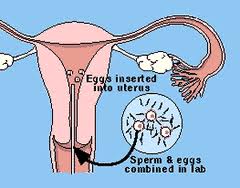At a recent conference in Montreal/Canada about “Measuring Human Embryo Quality” several IVF research groups exchanged the latest on single embryo transfer, which has become the standard for in vitro fertilization. These techniques are important for treating infertile couples.
In the past an in vitro fertilized egg was implanted into the woman’s uterus, but the success rate of a normal pregnancy was extremely low (in the order of 15% to 20%).
Subsequently more than one fertilized egg was implanted to improve the success rate, but this led to twins, triplets and multiple pregnancies with a high complication rate and death due to premature deliveries. Subsequently it was found that the success rate was much higher after a few cell divisions, which were allowed to take place outside the uterus in vitro cultures. Dr. William Schoolcraft (director of the Colorado Centre for Reproductive Medicine at a private clinic in Englewood, Col.) reported that embryos that were cultured for 5 days until the blastocyst stage in vitro are much more stable for implantation.
For the past 5 to 6 years they and other groups have only employed this technique, which according to him is now the gold standard. Although they were largely still using two embryos for transfer into the uterus for IVF. It has become increasingly clear that the risk of twin pregnancies in these already high risk situations is ranging from 4- to 10-times the risk of a single embryo transferred (singleton) into the uterus. Because of this his group has decided to only do singleton transfers. The other new finding is that it matters tremendously what culture medium is used for incubating the fertilized egg for the 5 day period in culture and what the exact conditions are. They found that for optimal results they have to use two different growth media, the first 3 days a low glucose or glucose free medium that mimics the environment of the fallopian tube. On day 4 and 5 the medium must mimic the environment inside the uterus, which requires it to be rich in amino acids and contain glucose.
An embryologist, Dr. Barry Behr from the Stanford University Medical Centre in California, reported that the same culture medium is not necessarily suitable for all patients, but individualization and close observation of the wellbeing of the embryo and the mother is necessary. To optimize maximum quality of the embryos growth factors may also have to be introduced into the culture medium and further research is going on in this direction.
This report is based on a summary in The Medical Post , June 24, 2003, page 8.
Here is a useful link regarding the topic of infertility: http://www.nethealthbook.com/articles/infertility.php
Last edited December 9, 2012






